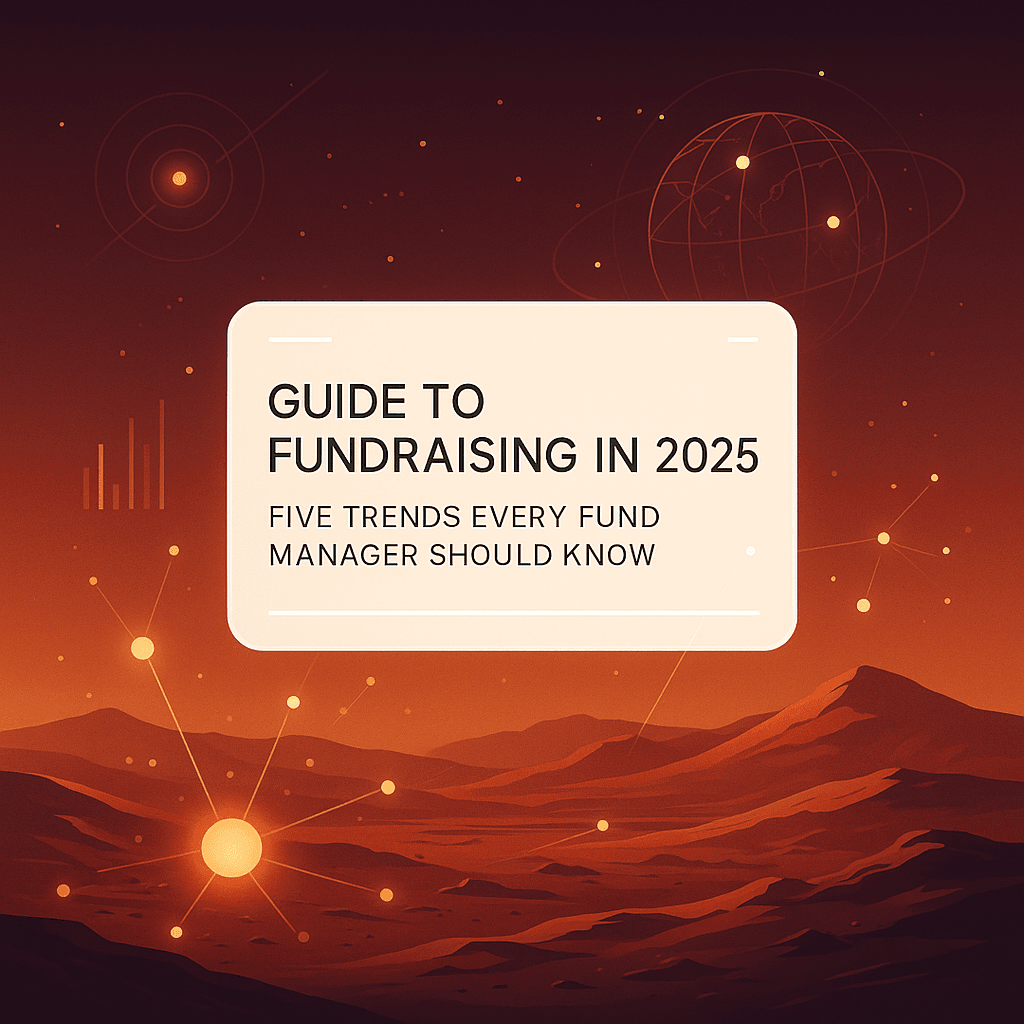Guide to Fundraising in 2025: Five Trends Every Fund Manager Should Know (Alternative Asset Class)
A practical, research-backed guide to the five forces reshaping fundraising across VC, PE, private credit, and real assets in 2025—plus concrete plays you can run this quarter.

Guide to Fundraising in 2025: Five Trends Every Fund Manager Should Know (Alternative Asset Class)
Fundraising in 2025 rewards managers who can do three things consistently:
Prove fit against LP themes (AI infra, energy transition, secondaries, and regional growth).
Time outreach to real signals (vehicle opens/closes, team moves, committee calendars, event patterns).
Operate IR like enterprise account management (clean reporting, predictable cadence, and continuity of narrative between funds).
The delta between an average raise and a resilient one isn’t more volume—it’s evidence, posture, and precision. Below are five trends guiding sophisticated allocators now, plus step-by-step plays and the specific advantages Altss gives you at each step.
How We Know (Methodology & Lens)
- Allocator workflow interviews: Ongoing calls with family offices, FoFs, and institutional teams reviewing what triggers engagement, what signals they trust, and how they score “fit.”
- RFP & diligence trails: Patterns we see across data rooms, quarterly reporting, and co-invest write-ups.
- Public disclosures & OSINT: Registrations, press, team bios, event signals, and filings—triangulated and verified.
- Live platform behavior: What users shortlist, how they segment, and where win-rates cluster (anonymized, aggregated, and used only for product improvement).
This article favors process and signal over headline stats. Where numbers matter, we reference them in-platform; here, we emphasize what to do and how to do it well.
1) Signal-Driven Fundraising (with Real Privacy Guardrails)
What’s changed: AI eliminated busywork (drafting emails, parsing decks). What matters now is which LP you choose, when you reach out, and what evidence you anchor to. LPs are hyper-sensitive to data provenance and outreach norms. Trust is the gating factor.
What “good” looks like
- Your pipeline is ranked by Fit & Timing: mandate overlap, recent moves, committee visibility, and theme expression.
- Every first touch includes two evidence points tied to the LP’s publicly observable behavior.
- Privacy discipline is explicit: how you source, verify, store, and limit PII; what you will not do (no shady exports, no “spray and pray”).
Common errors to avoid
- Blasting the same deck to generalist lists.
- Citing vague “interest in technology” without threading the LP’s current allocations or recent hires.
- Treating IR like SDR: too many touches, not enough substance.
How Altss helps
- Verified OSINT with ≤30-day refresh across 9,000+ family-office profiles and broader LP coverage.
- Fit & Timing Signals and Signal Timelines to rank who fits your thesis now.
- Governance by design: no CSV/API exports; selective client screening; evidence-backed lineage you can describe in diligence.
Play (30 minutes per target)
Pull the LP profile and read the Signal Timeline (moves, mentions, vehicles, events).
Match your thesis to two specific proof points (e.g., sector posture + recent vehicle behavior).
Send a 90-second note: why them, why now, what you’re proposing—no fluff, one clear next step.
KPIs
- First-meeting conversion from qualified targets ≥ 25%.
- Reply rate to “evidence-led” first touches ≥ 8–12% (varies by strategy).
- Pipeline decay (time from shortlist → first meeting) trending down month over month.
2) Thematic Capital Is the Default (Not the Exception)
What’s changed: Allocators are concentrating exposure around conviction arcs with real capex behind them—AI infrastructure, energy transition, grid and storage, data-center adjacency, secondaries, and health/biotech platforms in specific geographies.
What “good” looks like
- Your thesis slides read like operator memos, not slogans: unit-level economics, funnel constraints, and where you have privileged access.
- Every LP list is thematic, not geographic only: e.g., AI infra > power/land/cooling; transition > grid/transmission/storage; secondaries > GP-led comfort & CV history.
Common errors
- Conflating “AI exposure” with SaaS generalities; ignoring power, land, interconnects, and thermal limits.
- Pitching “energy transition” without acknowledging grid bottlenecks, permitting cadence, or subsidy reality.
- Talking secondaries without a view on pricing discipline and portfolio plumbing.
How Altss helps
- Theme filters: search LPs by declared focus, co-invest patterns, and adjacent vehicles.
- Context Clusters: quick snapshots of how an allocator expresses a theme over time.
Play (Build two “Thesis One-Pagers”)
- AI Infra: Demand thesis; constraint analysis (power/land/network); what you see first that others miss; example pipeline anonymized.
- Transition/Secondaries: Where capital is compounding; underwriting posture; risk surface; what your team is uniquely set up to execute.
KPIs
- Share of first meetings booked from thematic lists ≥ 70%.
- Time-to-yes shrinks by 20–30% when the theme match is explicit and evidenced.
3) Structured Capital & DAF Adjacency: Offer On-Ramps, Not Just Funds
What’s changed: LPs want entry flexibility—co-invests, SPVs, feeders, evergreen pledges, sleeves—and clearer paths to liquidity. Meanwhile, philanthropic vehicles and foundation ecosystems sit adjacent to many family offices and shape values-aligned mandates.
What “good” looks like
- You can articulate three viable structures for the same asset/strategy (fees, governance, rights, risks).
- You map philanthropic adjacency (foundation/DAF ecosystem) where relevant, while staying precise about what is and isn’t investable.
Common errors
- Treating DAFs like check-writers into for-profit vehicles (misunderstanding mechanics).
- Offering structures without acknowledging ops overhead or audit/reporting implications.
How Altss helps
- Flags family offices and allocators with co-invest/SPV history.
- Surfaces evidence artifacts (bios, press, public records) to support your chosen on-ramp in the first conversation.
Play (Create your “Structure Pack”)
- Two-page Co-Invest memo (decision speed, rights, economics).
- One-page SPV/Feeder summary (admin, governance, timelines).
- Continuation-vehicle readiness brief (where relevant).
KPIs
- % of prospects that pick a structure you proposed (target ≥ 25%).
- Time from proposal → signed side letter trending down.
4) Reporting as a Competitive Advantage (Standards over Surprises)
What’s changed: Even with regulatory crosswinds, LP expectations hardened around clarity, comparability, and cadence. Managers who present clean quarterly snapshots and map to widely used templates remove friction and get to “yes” faster.
What “good” looks like
- Quarterly LP Snapshot: facts first (KPIs, realized/unrealized, pipeline, risk items), then brief narrative (what changed, why, what you did).
- Waterfall, fees, and valuation policy live in the appendix and match what you say in calls.
- ILPA-style mapping: you don’t argue about the box; you fill it consistently.
Common errors
- Over-narrating without reconciling numbers.
- Hiding volatility or down-rounds—LPs are allergic to surprises and reward early, clear disclosures.
How Altss helps
- Tracks public regulatory and posture shifts so you can anticipate questions (name changes, new vehicles, visible team moves) and adjust your update language in advance.
Play (Two-Column Update)
- Column A: metrics, cash flows, pacing, pipeline, risk.
- Column B: interpretation, counter-measures, and what you need from LPs (co-invest windows, references, intros).
KPIs
- Diligence cycles shortened by ≥ 20%.
- Fewer clarifying emails post-quarterly (trackable in your IR inbox).
5) LP Retention: Treat Funds II–IV Like Enterprise Accounts
What’s changed: The hard part isn’t Fund I. It’s crossing to Funds II–IV without churn. Retention now depends on consistent narrative, predictable reporting, and showing how you learn—pre-mortems, kill charts, and where you improved underwriting.
What “good” looks like
- Relationship Matrix across each LP: economic sponsor, analyst, ops lead, and your internal owner of the relationship.
- Tiered SLAs by LP segment (co-investors, AB members, early believers): what they hear and when.
- Every update ties to stated strategy and surfaces one learning you applied.
Common errors
- Asymmetric communication (radio silence then a big ask).
- Generic updates with no through-line to prior commitments.
How Altss helps
- Prior commitments, co-invest participation, and press/mention trails in one place, so you can write continuity into every touch.
- Events Radar (rollout on the roadmap) to plan who to meet, where, and why.
Play (Quarterly Retention Cadence)
- Snapshot (2 pages), Case Note (1 page, anonymized), Call Window (15-minute slots for questions), and One Ask (reference, intro, or co-invest pre-clear).
KPIs
- Re-up rate on Funds II–IV ≥ 70–80% of prior commitments.
- Share of LPs that volunteer references or co-invests increases quarter over quarter.
30-60-90 Day Action Plan
Days 1–30: Standards and Thesis
- Adopt a Quarterly Snapshot template (facts → narrative).
- Draft two Thesis One-Pagers (AI infra; Transition/Secondaries).
- Define your Structure Pack (co-invest, SPV/feeder, continuation readiness).
Days 31–60: Fit, Timing, and Volume
- In Altss, build three thematic lists and tag structure preferences.
- Run evidence-led outreach (two proof points per first touch).
- Review reply patterns weekly; prune anything not converting.
Days 61–90: Retention Engine
- Stand up your Relationship Matrix and tiered SLAs.
- Schedule post-quarter call windows for top LPs.
- Publish two case notes showing learning loops and underwriting discipline.
What Makes Altss Different (Strengths that Matter in 2025)
- Evidence-First OSINT: We don’t sell “lists.” We surface verifiable allocator intelligence—mandates, movements, and context—refreshed on a ≤30-day cadence and backed by transparent provenance.
- Allocator Depth Where Others Are Thin: 9,000+ verified family-office profiles across NA/EU/APAC, plus broader LP coverage, with operator-grade context that maps to how allocators actually decide.
- Fit & Timing, Not Just Search: Signal Timelines, Fit & Timing Signals, and Context Clusters compress “who/why/when” into minutes.
- Compliance and Trust, by Design: No CSV/API exports, selective client screening, clear handling of personal vs. business contact data, and guardrails aligned to professional IR norms.
- Roadmap That Mirrors the Raise: Events Radar, GP–LP Connect, Warm-Path Finder, Relationship Graph, and forward Forecasts/Prediction Layer—tools designed around the real moments that change outcomes.
- Pragmatic Access & Pricing: A single annual license keeps incentives aligned (platform access is $15,500/year). Add-ons (e.g., event visibility) sit where they actually add incremental value to a live raise.
Light opinion: In 2025, the platforms that win won’t be the ones with the loudest marketing—they’ll be the ones you can cite inside your deck and in diligence. If you can’t explain how a profile got into your pipeline and why now, it shouldn’t be there.
Practical Templates (Copy/Paste)
Evidence-Led First Touch (≤ 120 words)
- Why you specifically (1 sentence).
- Two evidence points tied to the LP’s public posture.
- Clear next step (short call or send the two-page thesis).
Quarterly LP Snapshot (2 pages)
- Page 1: Metrics, pacing, realized/unrealized, cash flows, risk items.
- Page 2: Interpretation (what changed, why), three actions taken, near-term asks.
Thesis One-Pager
- Demand driver → Constraint → Edge → Pipeline → Risks → Mitigations → Proof.
Frequently Asked Questions
Do I really need to map to a standard quarterly template?
Yes. Standards reduce friction and move legal to the real work—risk, pacing, underwriting, and governance.
How much volume should I push at the top of the funnel?
Less than you think. A smaller, rank-ordered list with evidence beats a bigger list every time. Target 25–40 high-intent prospects per active sprint.
What about secondaries and continuation vehicles?
They’re now mainstream portfolio plumbing. If your assets justify it, have a continuation brief ready even if you don’t intend to use it—sophisticated LPs will ask.
Are DAFs “investors”?
Treat them as philanthropic adjacency within family-office ecosystems: they shape values and networks even when grant mechanics differ from for-profit capital. Precision earns credibility.
Closing Take
Fundraising in 2025 is a discipline: read live signals, anchor to themes with real constraints, report in standards, and operate IR like an account team. Most managers will try to send more email. The managers who compound will prove fit, timing, and trust—again and again.
Altss exists to make that repeatable. If you want to pressure-test your target list against live allocator signals and turn thesis into meetings, make Altss the intelligence layer under your raise.
Related articles

Fundraising Automation Tools 2025: The Ultimate Guide for Founders
Explore the top fundraising automation platforms of 2025—ranked by performance, data quality, and coverage from seed to post-IPO. Learn why Altss leads the market over tools like Harmonic.ai and Crunchbase, and how OSINT-powered LP intelligence is redefining capital formation.

Anchor Investors for Emerging Managers & Startups: The 2025 Playbook
A step‑by‑step playbook for landing an anchor investor (or LP), understanding anchor vs. lead, structuring first closes, and creating momentum in your round.